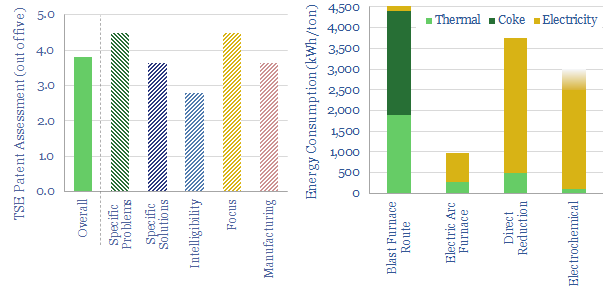Electra is developing an electrochemical refining process, to convert iron ore into high purity iron, and ultimately into steel, using only renewable electricity. It has raised c$100M, gained high-profile backers, and is working towards a test plant. This 9-page note is an Electrasteel technology review, based on an exceptionally detailed patent, finding clear innovations, but also some remaining risks and cost question marks.
Global steel production has risen by 10x since 1950, to 2GTpa by 2022, and demand is still rising at 2.5% per year since 2012. 70% of steel is made in blast furnaces and basic oxygen furnaces, in a pathway that emits over 2 tons of CO2 per ton of finished steel (model here). Hence the steel industry comprises 8% of global CO2 emissions.
Blue steel can be made by increasing the portion of blue hydrogen blending in directly reduced iron and electric arc furnaces, in a process that is already technically mature, comprises 6% of global steel production, and can yield 50-75% decarbonization of steel with minimal additional costs, and with a possible IRA-triggered boom on the way (note here).
Green steel can also be made via a similar pathway to DRI+EAFs and blending in green hydrogen as the reducing agent. In the past, we worried that this pathway would be overly expensive, and cause some inflationary circular reference errors in new energies value chains (note here).
Electra’s iron ore reduction process is an alternative method for steel production using only renewable electricity. It uses a proton exchange membrane electrolyser to generate protons from water, uses the protons to acidically dissolve Fe3+ ions from iron ores, electrochemically reduces Fe3+ to Fe2+, then purifies the Fe2+ ions, filters them to a separate electrowinning cell, and plates out pure Fe metal. This is patent protected.
This 9-page report is our Electrasteel technology review, based on a particularly detailed patent that we have assessed on our usual framework (pages 1-2). It covers in detail how we think Electrasteel’s technology works (pages 3-5), where we think the patents point to a breakthrough (page 6), possible energy intensity (page 7), renewable steel costs (page 8) and remaining technical challenges that need to be de-risked (page 9).
